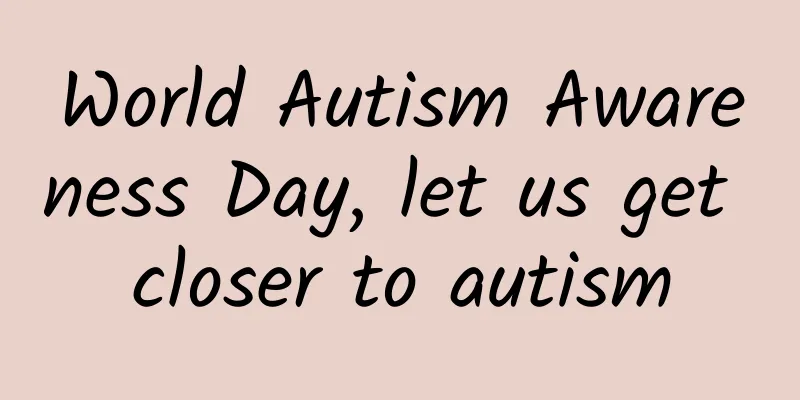World Autism Awareness Day, let us get closer to autism

|
April 2, 2024 is the 17th World Autism Awareness Day. This year's publicity theme slogan is: "Lifelong service, all-round care", aiming to promote all-round service support and care for people with autism throughout their lives, and help people with autism integrate into society. What are the symptoms of autism spectrum disorder and how is it diagnosed? Autism Spectrum Disorders (ASD), also known as autism or autism in Chinese, is a complex neurodevelopmental disorder. Epidemiological surveys in various countries show that the prevalence of this disease is 1-2%, and it is one of the main causes of mental disability in children. The core symptoms of autism are social interaction and communication disorders, restricted interests, and repetitive stereotyped behaviors, but the differences between different patients are very large. Therefore, it is difficult for ordinary people to identify and detect it early. There is currently no clinical test method that can help doctors confirm the diagnosis as a gold standard. The diagnosis is mainly based on behavioral diagnosis, parent reports and doctor observations, combined with screening scales. Can autism be cured? Autism develops early, often before the age of three. The medical and academic communities generally agree that there is no cure, and there are no effective drugs or methods for the core symptoms. However, the fact that a disease cannot be cured does not mean that we are helpless against it. If children with autism can be diagnosed early, receive intensive behavioral training in a timely manner, and persist for a long time, they can hopefully correct and make up for their defects and live, go to school, and work normally like other people. The most effective clinical intervention is behavioral intervention. Currently, Applied Behavior Analysis (ABA) is the most widely accepted and applied behavioral intervention method. The goal of ABA is to shape and strengthen new behaviors, such as learning to speak and play, and to reduce behaviors that people do not want to see. Data from multiple clinical trials have confirmed the effectiveness of ABA training, and it has been developed into a structured method system in clinical practice. Therefore, as a scientific and effective training method, it has been widely used in the treatment of autistic patients. Studies have shown that early intensive behavioral training is effective for some children with autism, can reduce or even prevent serious complications and related defects, and may also improve IQ, language and daily functional skills, which is also called "adaptive behavior." Generally speaking, most children can benefit from early intervention treatment. Therefore, early detection, early diagnosis and early intervention are very important. What are the related treatment drugs for autism? Social communication and language disorders, repetitive stereotyped behaviors and restricted interests are the core symptoms of autism, and are also typical clinical functional disorders that seriously affect the normal life and work of autistic patients. So far, there is no drug that can treat the above core symptoms, but some co-occurring diseases can be treated symptomatically with drugs, such as epilepsy. Drugs with clear indications can only be used as auxiliary methods to control some serious symptoms, especially more serious psychiatric symptoms or behavioral problems, such as severe anxiety, irritability, compulsion, aggression, self-harm, etc., to improve the quality of life of autistic patients and their families. These drugs were once used to treat non-autistic spectrum disorders, and later it was found that they could also be used to alleviate similar symptoms of autism spectrum disorders. Therefore, autism spectrum disorders were added as a clinical indication for this type of drug. Currently, the U.S. Food and Drug Administration (FDA) has approved two drugs for autism spectrum disorder patients that target individual symptoms of autism. Both are atypical antipsychotics. They are introduced as follows: 1. Risperidone Risperidone is a dopamine antagonist with anti-serotonin, anti-adrenergic and anti-histamine properties. Its pharmacological action is to reduce the levels of dopamine, adrenaline and norepinephrine in the brain. Risperidone has been on the market since 1994. Its main indications include schizophrenia, mania and increased irritability and excitability associated with autism. It is widely used in the first two. In 2006, the FDA certified that the drug can control irritability, aggressive behavior and self-injurious behavior in children or adolescents with autism spectrum disorders aged 4-16 years. This is the first approved drug that can be used in people with autism spectrum disorders, and it is also the most representative drug currently used to treat autism spectrum disorders. 2. Aripiprazole Aripiprazole is a second-generation atypical antipsychotic drug. It is a partial dopamine receptor antagonist that has an excitatory effect on dopamine D2 receptors and 5-hydroxytryptamine 1A receptors, and an antagonistic effect on 5-hydroxytryptamine 2A receptors. Aripiprazole was approved by the FDA for the treatment of schizophrenia in 2002, and later bipolar disorder and major depressive disorder were added as its indications. In 2009, the FDA approved the drug for the treatment of self-injury, irritability, aggressive behavior, and sudden mood changes in children or youth with autism spectrum disorders aged 6-17 years. It should be noted that both drugs are psychotropic drugs. It is recommended that parents should give the drugs to their children under the strict guidance of doctors, and should assist doctors in observing the efficacy and side effects of the drugs in the long term. The most common side effects of risperidone are: increased appetite, fatigue, drowsiness, constipation, dry mouth, and increased prolactin secretion; the common side effects of aripiprazole for children are: drowsiness, headache, vomiting, extrapyramidal symptoms, fatigue, increased appetite, insomnia, nausea, nasopharyngitis, and weight gain. Both drugs may cause withdrawal symptoms when they are discontinued, such as: drowsiness, nausea and vomiting, headache and dizziness, sweating, movement disorders, orthostatic hypotension, rapid heartbeat, nervousness, dizziness, excessive crying, anxiety, etc. Therefore, under the guidance of a doctor, the drug should be slowly reduced and discontinued, and it should not be discontinued abruptly. These drugs can only alleviate the severe mental and behavioral symptoms of some children, but cannot solve the core social communication disorders of children with autism. They still need to adhere to regular behavioral training and treatment. People with autism spectrum disorders need our understanding and care. On the 17th World Autism Awareness Day, we call on everyone to pay attention to and understand people with autism, and to provide them with support and help throughout their lives. References: [1] Association, AP 2013. Diagnostic and Statistical Manual of Mental Disorders, 5th Edition: DSM-5 (5 ed.): American Psychiatric Publishing [2] FDA. 2022. FDA approved label on 12/02/2022 for RISPERDAL, NDA no. 020272 [3] FDA. 2022. FDA approved label on 11/30/2022 for ABILIFY, NDA no. 021436 |
<<: 13 deaths so far this year! Coughing is not good, beware of whooping cough
Recommend
Why do I have back pain during pregnancy?
In the second month of pregnancy, the uterus has ...
What are the clinical manifestations of malignant and benign uterine cysts?
I believe everyone knows the importance of the ut...
Which is more nutritious, black chicken soup or old hen soup? What kind of black chicken is good?
I believe everyone knows that chicken soup is nut...
Why can't the sweet and sour pork be coated with paste? How to make the sweet and sour pork paste
Sweet and sour pork is very delicious when we eat...
Does Jia Baoyu only love Lin Daiyu? Why is Jia's mother so cruel to Lin Daiyu?
The love story of Jia Baoyu and Lin Daiyu is very...
Why is the jelly orange red inside? Why is the jelly orange so soft?
Jelly orange has the characteristics of both oran...
Women should not drink green tea during menstruation
For women during menstruation, drinking green tea...
How many days does it take to stop bleeding after taking Mafulong?
Among various gynecological diseases, bleeding is...
A woman dreams of others being injured and bleeding
In daily life, everyone sometimes encounters some...
Correct lactation technique diagram
Many people feel that exclusive breastfeeding is ...
Chinese medicine for female urinary tract infection
Our body needs a lot of water every day to mainta...
Can I get better if I have lobular hyperplasia of the breast?
Lobular hyperplasia of the breast can cause patie...
Dark blood color before and after menstruation
Women are more likely to suffer from various mens...
What is the cause of increased leucorrhea before menstruation?
All physical reactions of women during their mens...
Will painless uterine curettage hurt?
Curettage, which we often call curettage, was a c...









